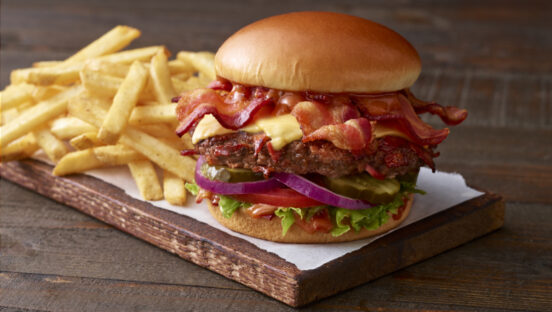





Mark Jeffers, executive chef, and food and beverage director at Truckee, California’s The Ritz-Carlton, Lake Tahoe bumps up flavor with a black garlic aioli at the restaurant, Manzanita. The garlic’s slow, 60- to 90-day cooking process creates a profile of “sticky and sweet with a bit of sourness, almost like balsamic vinegar or tamarind,” Jeffers says. The decadent, tangy black garlic aioli is blended with egg yolks, mustard, oil, salt, and pepper, and added to prime-aged ribeye, caramelized shallots, wild mushrooms, and peppercorn jus.
At Philadelphia, Pennsylvania’s Vedge, chef and co-owner Rich Landau whips rutabaga into a cheesy fondue. The nutty rutabagas are boiled in salt water while shallots, garlic, salt, and pepper are sauteed. Nutritional yeast and miso are caramelized in the pan to give rich, cheesy notes, then the pan is deglazed with the salt water. The drained rutabagas and some reserved salt water are then blended with the sauteed ingredients, tofu cream, sunflower oil, and sherry vinegar. House-made soft pretzels and pickles are then served with the fondue.
Plucking from the farmer’s market, Brad Wise, executive chef/owner of San Diego’s Hundred Proof, adds acidity with pickled peaches in his seasonal charcuterie and cheese plate. A jalapeño and herbal tea pickling liquid pickles under-ripe peaches. Then the acidic, still-crunchy peaches, burrata, house-cured prosciutto, raspberry and rhubarb gastrique, arugula, sumac, and toasted focaccia complete the dish.
Scooping oceanic inspiration with plankton powder is Tim Labonte, executive chef of Portland, Maine’s BlueFin at Portland Harbor Hotel. “If you think of a misty, foggy day where the smell of the ocean permeates the air, that’s plankton, and this dish tastes like eating the ocean,” Labonte says. Maine halibut gets pan-seared while plankton powder is sifted into the melted butter sauce. At plating, halibut is drizzled with the sauce, dusted with the powder, and served with pickled fennel, citrus segments, sugar kelp noodles, and uni aioli.
Cultivating comfort through an Indian fenugreek dish is Surbhi Sahni, creative director and chef at New York’s SAAR Indian Bistro. “I’ve been eating this since I was a baby; it’s very nostalgic,” Sahni says. “Fenugreek is multifaceted and can be used as a spice, flavoring agent, vegetable, or stuffed inside breads.” Fresh fenugreek leaves, with sweet, bitter, smoky, and maple-y notes, are sauteed with cumin seeds, garam masala, green chilies, and salt. Caramelized potatoes are incorporated for texture and bite, and the dish is served with paratha.
Brandon Carter, chef/owner of Bluffton, South Carolina’s FARM, pulls from Italian family ties by adding dashes of fish sauce, Colatura di Alici, to dishes. “I was intrigued when I found there was a fish sauce made in Italy, and the first time I tasted it, it blew me away with this special level of refinement,” Carter says. Adding umami and saltiness, the Colatura di Alici is paired to tuna crudo with agrumato, green olives, tomato conserve, basil, orange zest, and raw red onion.








